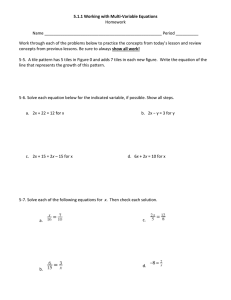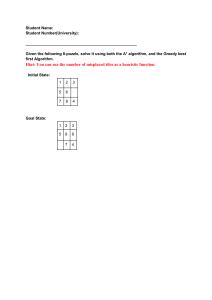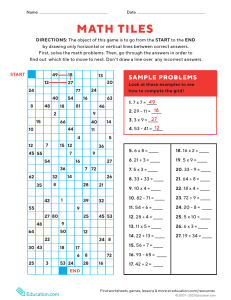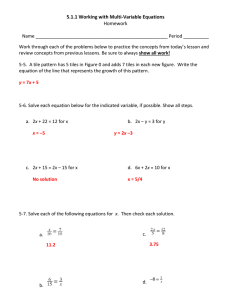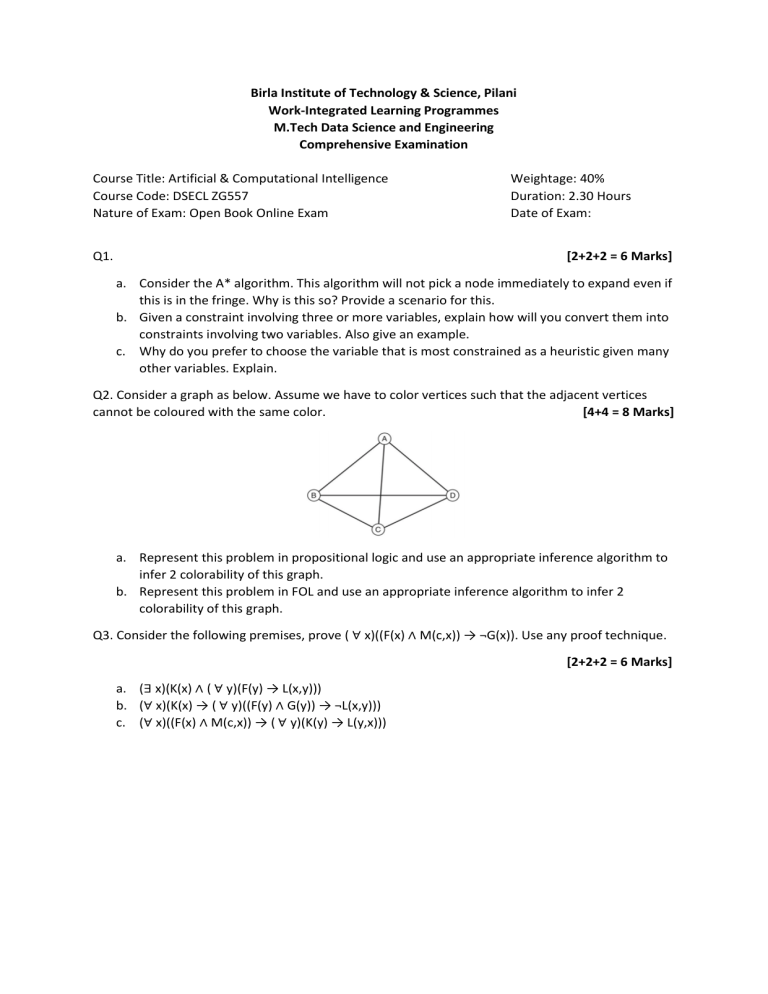
Birla Institute of Technology & Science, Pilani Work-Integrated Learning Programmes M.Tech Data Science and Engineering Comprehensive Examination Course Title: Artificial & Computational Intelligence Course Code: DSECL ZG557 Nature of Exam: Open Book Online Exam Q1. Weightage: 40% Duration: 2.30 Hours Date of Exam: [2+2+2 = 6 Marks] a. Consider the A* algorithm. This algorithm will not pick a node immediately to expand even if this is in the fringe. Why is this so? Provide a scenario for this. b. Given a constraint involving three or more variables, explain how will you convert them into constraints involving two variables. Also give an example. c. Why do you prefer to choose the variable that is most constrained as a heuristic given many other variables. Explain. Q2. Consider a graph as below. Assume we have to color vertices such that the adjacent vertices cannot be coloured with the same color. [4+4 = 8 Marks] a. Represent this problem in propositional logic and use an appropriate inference algorithm to infer 2 colorability of this graph. b. Represent this problem in FOL and use an appropriate inference algorithm to infer 2 colorability of this graph. Q3. Consider the following premises, prove ( ∀ x)((F(x) ∧ M(c,x)) → ¬G(x)). Use any proof technique. [2+2+2 = 6 Marks] a. (∃ x)(K(x) ∧ ( ∀ y)(F(y) → L(x,y))) b. (∀ x)(K(x) → ( ∀ y)((F(y) ∧ G(y)) → ¬L(x,y))) c. (∀ x)((F(x) ∧ M(c,x)) → ( ∀ y)(K(y) → L(y,x))) Q4. Recollect the case we have used in our HMM classes for predicting the weather by a guard posted in an underground installation from the text book example. We have used the following model of the scenario: [3+1+3 = 7 Marks] a. Compute P(R3| U1 = True ) b. How accurate will be our prediction, P(Rk| U1 = True ), when k >> 1? Explain. c. Compute P(R2| U1 = False, U2 = False, U3 = True, ) Show steps. Q5. The sliding-tile puzzle consists of three black tiles, three white tiles, and an empty space in some order. The goal is to arrive at the goal configuration shown below by legal moves [B- Black tile, WWhite tile]. [2.5+2.5+3 = 8 Marks] The puzzle has two legal moves with associated costs Move #1: A tile may move into an adjacent empty location. This has a cost of 1. Move #2: A tile can hop over one or two other tiles into the empty position. This has a cost equal to the number of tiles jumped over a. What are measures using which the complexity of a state space can be measured. List each of them and provide the corresponding expression / value for this problem. b. Write down an admissible heuristic function h(n) for this problem with a formal description. Explain why this proposed heuristic is admissible. c. Generate the A* search tree (using tree search) starting with the following start state for depth up to 3 or until the goal state is reached, whichever is earlier Q6. You have been asked to solve below linear equation problem with multiple variables: [5 Marks] 2a + 7b -5c +d = 0 where a, b, c, and d are integers in the range [-20,20] (equation can have more than one solution) You have decided to solve this question using genetic algorithm. Show all the steps involved in solving this using Genetic Algorithm. Number each of your steps, and provide appropriate title to those steps. (No need to get the final solution, just the first iteration of each step involved in the algorithm) ***************************** All the Best for your Examination *************************

